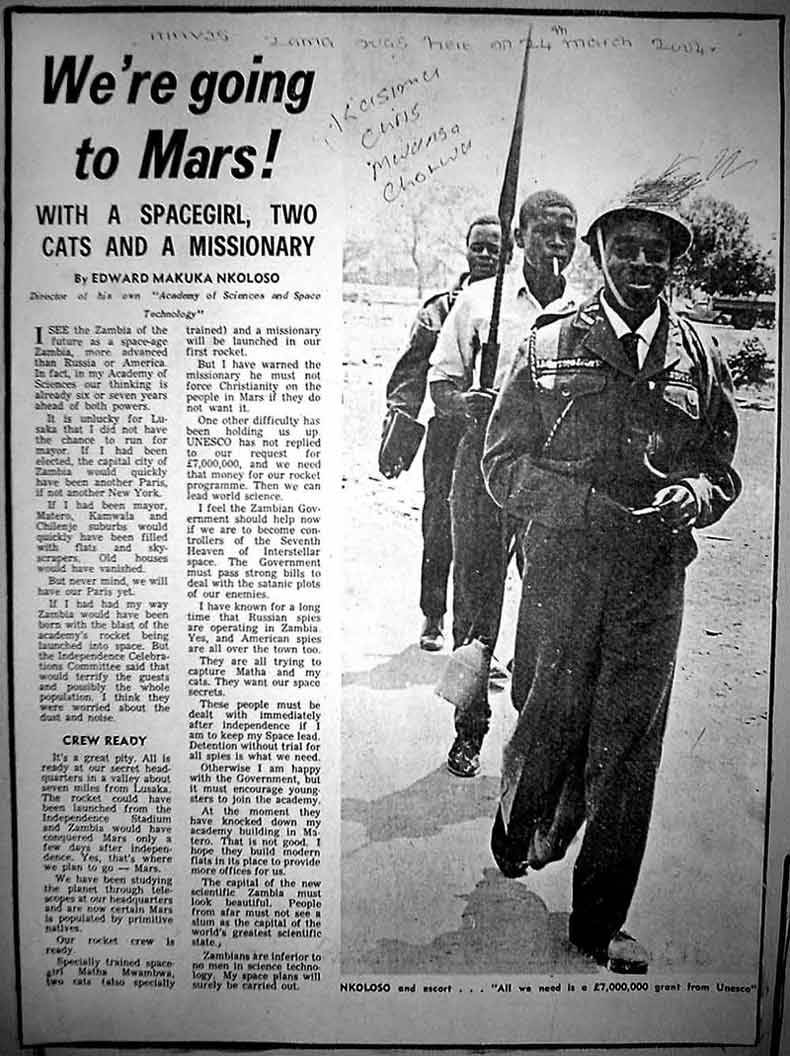The other space race competitor — The Zambian Space Program of 1964Recently the death of Neil
The other space race competitor — The Zambian Space Program of 1964Recently the death of Neil Armstrong has brought back memories of the Apollo missions, the space race, and the first moon landing. While the United States and the Soviet Union competed fiercely for the best in space technology and raced to send a man to the moon, one other competitor is often overlooked.Zambia, a country located in southern Africa, had recently gained its independence from Britain and to the Zambians it seemed as though anything was possible. One Zambian, a science teacher named Edward Mukaka Nkoloso had especially bold plans indeed. In 1964 he established the Zambian Academy of Science, Space Research, and Philosophy. He recruited a dozen astronauts, mostly uneducated local peasants, and created a special training facility seven miles from the city of Lusaka. The trainees, dressed in overalls and British army helmets, went through a brutal series of training exercises. In order to simulate the weightlessness of space the astronauts would swing on a large tire swing, when reaching the apex of their arc Nkoloso would cut the rope. They also used a space capsule simulator (a 44 gallon oil drum), in which they would sit and then be rolled down a hill, mimicking the actions of a space capsule entering the Earths atmosphere. Later the drum would be fired from a large catapult to simulate takeoff procedures. Nkoloso’s astronauts also had to be in peak physical performance, practicing calisthenics daily and running a large “junkyardesque” obstacle course.Edward Nkoloso had ambitious plans for his new space program. He intended to beat both the Russians and the Americans to the moon by 1965. He also had plans to send ten cats to mars, a prelude to a larger mission involving the Zambian colonization of Mars. In a newspaper editorial, Nkoloso revealed that he had discovered, via a telescope he had built, that Mars was inhabited by a race of primitive savages. He emphasized that he would not force the native Martians to convert to Christianity.The only problem with Nkoloso’s plan (I’m stretching the word “only” here) was that he lacked a rocket or spaceship. He petitioned UNESCO (United Nations Educational, Scientific, and Cultural Organization) for 7million pounds ($11 million) in order to build his rocket.Unfortunately things began to unravel for Nkloso. First his top astronaut, a 17 year old girl named Matha Mwamba (chosen to take care of the cats sent to Mars), became pregnant and was taken back to her village by her parents. With Mwamba’s departure most the male astronauts also quit the program. The government of Zambia distanced itself from the program, seeing Nkoloso and his crew as a band of crackpots. Finally UNESCO never coughed up the money necessary for Nkoloso to build his rocket.The Zambian space program was doomed to failure. On July 20th, 1969 Apollo 11 landed on the moon, and astronaut Neil Armstrong became the first man to walk on the moon. Tears streamed down Nkoloso’s eyes as the first moonwalk was televised worldwide. Actually, I don’t know how Nkloso felt about the moon landing, but one cannot help but admire the bravery and boldness of people like Neil Armstrong, Edward Nkoloso, Matha Mwamba, and the astronauts of the Zambian Space Program. -- source link
Tumblr Blog : peashooter85.tumblr.com
#history#space#science#astronauts#moon#mars#space race#neil armstrong#funny#africa#zambia
